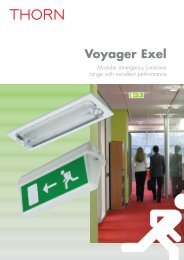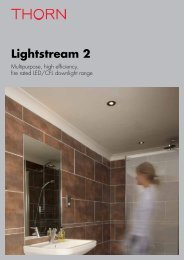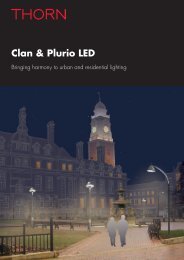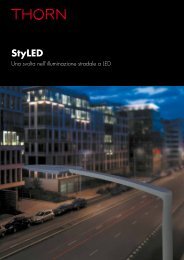Champion - THORN Lighting
Champion - THORN Lighting
Champion - THORN Lighting
Create successful ePaper yourself
Turn your PDF publications into a flip-book with our unique Google optimized e-Paper software.
The key concern of<br />
astronomers with regards to<br />
external lighting installations is<br />
the potential contribution to<br />
artificial sky glow, which can<br />
prevent us from seeing the<br />
stars at night.<br />
11<br />
<strong>Champion</strong> for astronomers<br />
Artificial sky glow<br />
Artificial sky glow is caused<br />
by a combination of direct and<br />
indirect contributions.<br />
Direct contributions<br />
to sky glow<br />
Direct contributions come from<br />
the upward light output of<br />
floodlights above the horizontal<br />
axes of their installed positions.<br />
This can be eliminated by the<br />
use of horizontal ‘flat glass’<br />
floodlights, but only if the<br />
floodlights are installed with the<br />
light emitting surface parallel to<br />
the ground.<br />
However, the increasingly<br />
demanding ‘on-pitch’ lighting<br />
requirements of sports<br />
installations will often require<br />
more than simple side-to-side<br />
rotational adjustment of the<br />
floodlights.<br />
If the peak intensity angle of the<br />
floodlight is too low (i.e. it is not<br />
sufficiently asymmetric), it will<br />
need to be tilted so that sufficient<br />
lighting and uniformity levels are<br />
provided in the centre of the<br />
sports pitch. This will increase<br />
direct contributions to sky<br />
glow and the possibility<br />
of light trespass.<br />
If tilting is out of the question,<br />
then the quantity of floodlights<br />
could be increased. However,<br />
this can result in ‘over-lighting’<br />
of the installation and subsequent<br />
increases in Indirect contributions<br />
to sky glow (see below).<br />
Another alternative could be to<br />
increase the mounting height<br />
of the floodlights, but this will<br />
increase the costs of the masts.<br />
Therefore, in reality, ‘flat glass’<br />
floodlights’ are very rarely<br />
installed ‘flat’, rather diminishing<br />
the arguments for using this<br />
type of floodlight.<br />
However, <strong>Champion</strong><br />
has an adjustable lamp<br />
feature, which can provide a<br />
variety of different light outputs<br />
from a single installed position<br />
(e.g. with the virtual light emitting<br />
surface parallel to the ground).<br />
Indirect contributions<br />
to sky glow<br />
Indirect contributions come from<br />
the upward light reflected from<br />
the ground. In sports, for<br />
example, grass can reflect up to<br />
10% of light while some artificial<br />
surfaces can reflect as much as<br />
25%. The indirect contribution<br />
from an installation can therefore<br />
be quite significant but is often<br />
ignored as a contributor to<br />
obtrusive light.<br />
Indirect contributions, unlike<br />
direct contributions, cannot be<br />
eliminated. There will always<br />
be some reflected light from an<br />
installation. However, we can<br />
seek to minimise it by lighting<br />
the target area to the lowest<br />
average lighting and<br />
uniformity levels consistent<br />
with the visibility requirements<br />
for the sport.<br />
Take, for example, a sports<br />
pitch requiring an average<br />
lighting level of 250 lux with<br />
a uniformity rating of 0.6.<br />
<strong>Lighting</strong> the pitch to less than<br />
250 lux and less than 0.6<br />
uniformity would mean that<br />
there is insufficient lighting<br />
for the participants. However,<br />
lighting the pitch to 300 lux<br />
would mean that the<br />
installation is ‘overlit’ by<br />
20%, thus increasing indirect<br />
contributions to sky glow<br />
by 20%.<br />
The innovative design concept<br />
of <strong>Champion</strong> not only enables<br />
it to be installed without tilting,<br />
thereby reducing direct<br />
contributions to artificial sky<br />
glow, but also to reduce the<br />
risk of over-lighting an<br />
installation, thereby reducing<br />
indirect contributions to<br />
artificial sky glow.


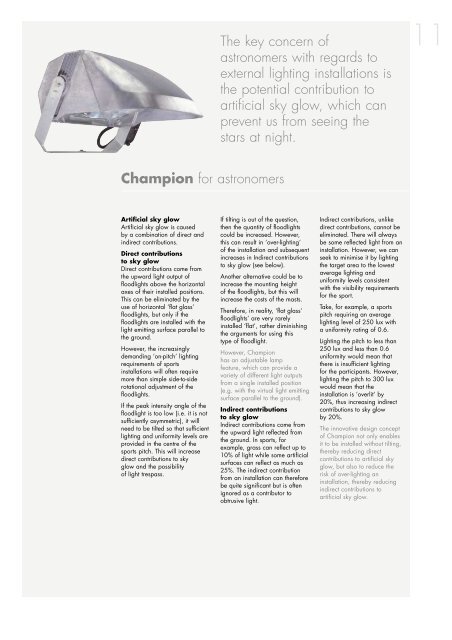
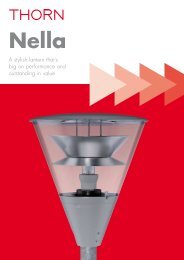
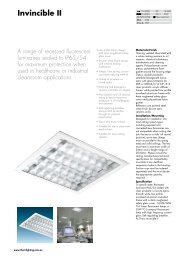
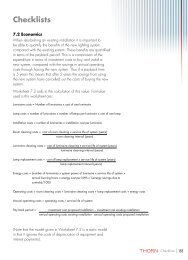
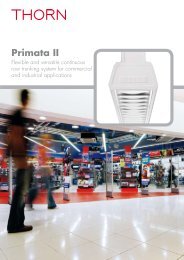
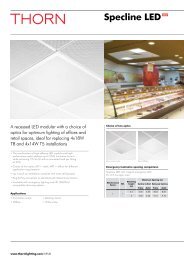

![Produkt brochure [PDF/4MB] - THORN Lighting](https://img.yumpu.com/50705283/1/184x260/produkt-brochure-pdf-4mb-thorn-lighting.jpg?quality=85)

